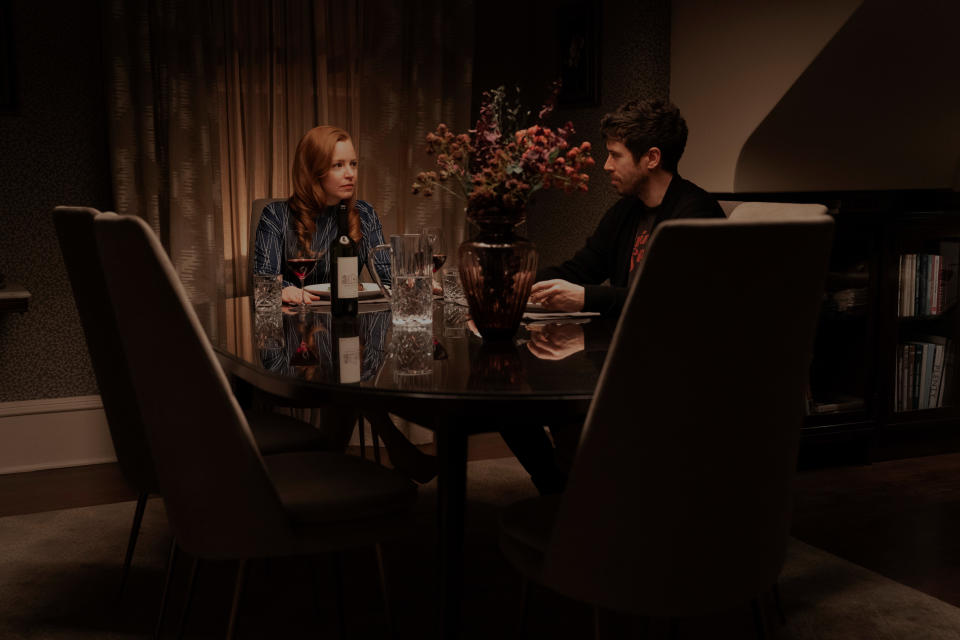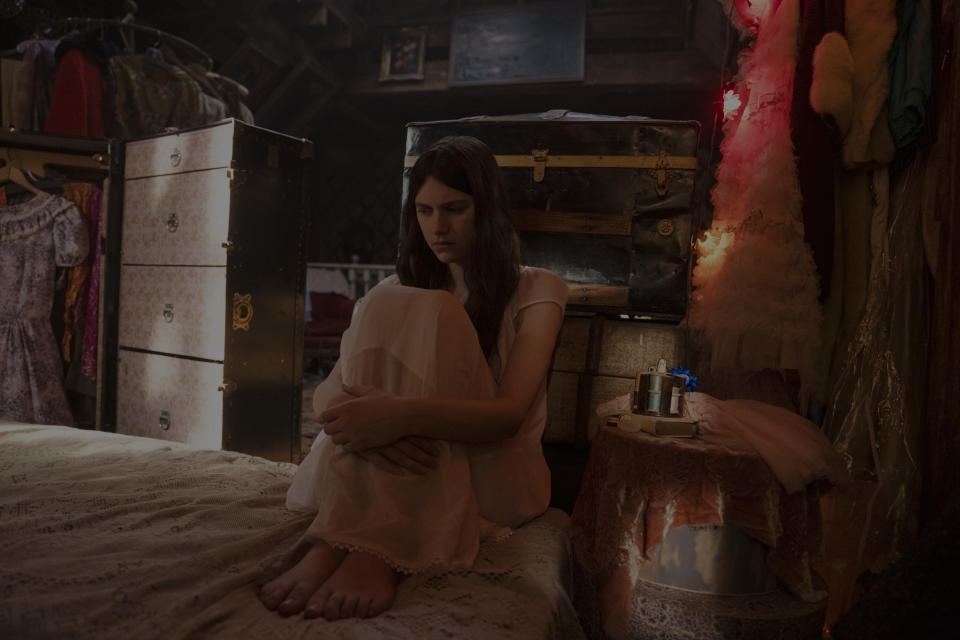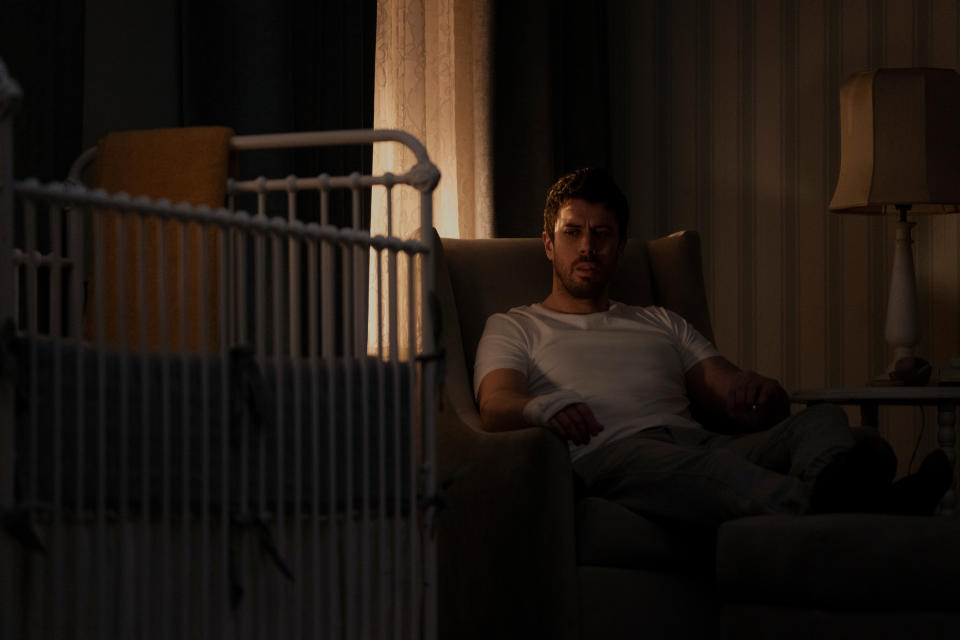‘Servant’: A Claustrophobic, Shape-Shifting Camera Defined the Shyamalan Fright

- Oops!Something went wrong.Please try again later.
On face value, “Better Call Saul” and “Breaking Bad” DP Marshall Adams might seem like an unusual choice to shoot episodes of M. Night Shyamalan’s Apple TV+ hit “Servant,” the tightly coiled psychological thriller set mostly in a single location. But that’s not how Shyamalan, the show’s executive producer, saw it. Known for his character-driven horror films that insinuate but rarely explain, Shyamalan, along with creator Tony Basgallop and a rotating team of directors and cinematographers, has successfully translated his (as Adams describes it) “super-contained, film noir” visual style into 20 cohesive half-hour television episodes across two seasons (with a third in the works).
To sustain the tension and energy across so many chapters, however, required more than a compelling visual approach: tight writing, powerful performances, and subtle shifts in perspective all play a role. And Adams’ expressive cinematography for the past five seasons of “Saul,” where camera moves often evoke the internal logic of the central character Jimmy McGill (Bob Odenkirk), was precisely what Shyamalan wanted to bring to the mix.
More from IndieWire
'The Morning Show' New Trailer: Reese Witherspoon and Jennifer Aniston Emerge from the Wreckage
The 'Ted Lasso' Holiday Special Hides a Blue Christmas Behind a Cavalcade of Cheer
Adams’ introduction to the show, the Season 2 episode “2:00,” turned out to be his masterclass in Shyamalan’s filmmaking style. “It was the perfect opportunity, with Night directing, to see the show through his eyes from the beginning,” said Adams in an interview with IndieWire. The episode’s opening shot also earned Adams his first Emmy nomination.
According to Adams, Shyamalan’s “very specific visual approach, like when we follow Dorothy (Lauren Ambrose) from below up the stairs, or when we’re booming down on Toby (Kebbell, as Sean) as he desperately searches for the attic key,” kept the DP on his toes. “You think, ‘How are we going to do this exactly?’ It keeps it challenging, but Night really knows what works visually. He has a sense about lighting all the time, too. He knows the best place to get the camera for lighting and he’s not afraid to be bold about it.”

Apple TV+
Much of this is hashed out during pre-production with storyboards, something Shyamalan encourages all of his directors to use. Adams spent his first four days on set in Shyamalan’s office with the director and his storyboard artist, Brick Mason. “The three of us developed a visual approach and came up with pretty much every shot you see in that first episode,” Adams said.
The show’s overall look, however, was set long before the cinematographer’s arrival on the semi-renovated brownstone set, all of it built from scratch in a series of adjacent rooms on a soundstage. “Night told me that from the start, he wanted to let the characters and the story itself bring the scariness through, and not do it through the look,” said Adams.
Shyamalan and his cinematographer Mike Gioulakis (“Split,” “Glass,” “Old”), who shot Season 1 in its entirety, initially achieved this with a sense of color balance. “The very blue, scary moments were countered with an abundance of rich, saturated colors, to make you feel like the inside of that house was warm and inviting — and keep you there,” Adams said. “The house and decor is very warm, and really inviting,” partly because it feels so fully inhabitable. The entire set, from bathrooms to kitchens, was outfitted with some 30 individual gas and water lines controlled by an elaborate distribution system mounted outside a set wall. “But it still scares the hell out of you!” As does the reborn baby doll standing in for the family’s dead son, Jericho, affectionately known on set as “Scary Jerry.”
Navigating so many predetermined parameters wasn’t as limiting as you might think. “Mike G did such a fantastic job on the first season, but he and I have different styles,” Adams said. “I’ve always been a firm believer that in trying to imitate somebody you end up becoming just a poor copy. You really have to carve your own way.” Sticking with similar colors and setups during Season 2 made sense on the same set, he said. “But if my style or lighting changes it up a bit, it’s not the end of the world. I learned a long time ago that that stuff can be a lot more forgiving than people think, mostly because you’re in the same space, with the same people, and you’re still in the story. I brought my own style to the show, but I did also try to stay with the look Mike had established.”
Those changes included radically fresh points of view, beginning with the opening shot of Episode 4. The camera hugs the floor as it follows Dorothy (Lauren Ambrose) up several staircases to a new door. She is bringing food to Leanne (Nell Tiger Free), whom she now has locked in the attic. “It was a tough and pretty involved shot” that went so well, he said, it set the bar for each scene and set up to follow. “We had a crane up on a platform so we could be dead-level when we traveled across the floor with the camera slung underneath it. I brought in a periscope lens to bring us even further down, so we could ride the floor like that.” Even with the periscope, he said it was a head scratcher to set up. “Luckily, at the bottom of those stairs, that whole back wall opens up, and it is the main crew access. We were able to get the crane in there without having to pull too much apart.”

Apple TV+
Adams later used the periscope lens to travel along an excavated and exposed sewage pipe in the basement and to match the unsettled extremity of the episode’s most violent scene between Dorothy and Leanne, shot through a layer of attic clutter. “The lowest thing on the camera is the lens itself,” he said. “It shoots at a perpendicular angle to the normal way you are behind the camera, so the camera is tipped facing almost all the way down. The 90-degree periscope on the end of it allows us to get unnaturally low.”
As the characters become more detached from reality, the angles and off-kilter framing intensify. An arresting overhead of Sean and Julian (Rupert Grint) sharing a bottle of wine begins with Julian’s reflection in his glass. “That shot was one Night had early on about detachment,” Adams said. “But when you start with the reflection in the wine glass that begins to ripple, you also immediately convey that the house is literally shaking from the jackhammering going on beneath them in the basement.”
The Arri Alexa LF Mini, a large-format camera beloved by film and drama series DPs for its compact size and relative lightness, was ideal, Adams said, for the crane and dolly shots inside the narrow hallways and tight corners on set, and for any number of ceiling, floor-hugging, mirror, or boom shots Shyamalan wanted. “I really love that camera,” he said. “It’s also very fast, so you can do a lot of things with not much light, especially in the attic,” a new set introduced in Season 2. “It opened up a whole new world of stuff that Nell [Leanne] could get into,” and Adams could light, including a very creepy mannequin and a giant oval mirror that further distorted perspectives.

Apple TV+
Long prime lenses brought another advantage to the cinematographer in the cramped space. “The longer primes don’t give you all of the distortion of the wide angle lenses but still give you extremely wide shots,” Adams said. “So with a very, very wide lens, like a 17mm or a 14mm, you don’t get the kind of distortion you’d get with a 35mm lens.” It also lets the camera behave like a character with a mind of its own, shifting off frame with clear-eyed, deliberate menace. In one memorable pan, Adams’ camera creeps across the characters at the dinner table and stops defiantly on a blank wall in an adjacent room.
Shyamalan made great use of everyone’s time on the contained set, made all the more isolated by the pandemic-related quarantine bubbles cast and crew navigated when filming resumed last September. “I’d never experienced this before but he likes to bring the actors in early when we’re still finishing the lighting a bit,” Adams said. “So as we’re tweaking and getting dialed in, he starts rehearsing with them and really finds the beats and the moments he’s looking for before we get rolling. That really helps. And the fact that we shot that first episode in sequence, you can see it develop as he goes along.”
“It was such a great collaboration with Night,” said Adams. “That entire episode turned out to be a fantastic way to get to know that show and the visual language he uses.” Adams understands now why so many on set have been with the Philly-based director for years. A risky sequence like the one in the final act of “2.00,” in which a character is literally (spoiler) buried alive in the basement, might spook even the most seasoned cast and crew. But everyone was on board, including the actress under the dirt. “It was a really scary and intense moment for all of us because Nell was actually breathing through that tube you see on camera,” he said. “Even though it’s all on stage, they still had to physically, and completely, bury her, covered in as little dirt as we could.”
Shyamalan’s indirect framing, which he worked out with Adams, gives the scene its chilling power, as does Dorothy’s complete role reversal, another classic Shyamalan narrative twist. “Because Night really likes to leave a lot to the imagination, we did that shot from underneath the stairs where you really couldn’t get a great look,” Adams said. “But you got just enough in those few seconds to know exactly what was going on.”
“Servant” Seasons 1 and 2 are available to stream via Apple TV+.
Best of IndieWire
Every IndieWire TV Review from 2021 So Far, Ranked by Best to Worst Grade
When Chuck Jones Brought a Working Guillotine to Protest Disney’s Labor Policies
Sign up for Indiewire's Newsletter. For the latest news, follow us on Facebook, Twitter, and Instagram.


